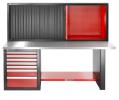.blog-menu-desktop ul {
background-color: #F1F1F1 !important;
width: fit-content;
float:right;
}
.blog-menu-desktop li {
display:inline-block;
font-weight: 600;
padding:0 15px;
vertical-align:text-top;
}
.blog-menu-desktop li a {
color:#000000;
}
.blog-menu-desktop li a:hover {
color:#E00519;
background-color: #F1F1F1;
}
.selected_category {
color:#E00519 !important;
}
.separator-border {
border-left:2px solid #000;
height:15px;
display:inline-block;
}
#misterworker-blog-menu .btn-primary:hover{
background-color: #e00819;
}
#misterworker-blog-menu-content ul {
background-color: #e00819;
padding: 10px 20px !important;
}
#misterworker-blog-menu-content ul > li {
margin-bottom:5px;
}
#misterworker-blog-menu-content ul > li > a {
color: #fff;
}
#misterworker-blog-menu-content ul > li > a:hover {
background-color: #e00819;
}
Discover the Main Types of Workbench
Published :
08/1/2022 09:22:36
Categories :
Mister Worker
, Professional working tools guide
On Mister Worker™ today we speak about the most common types of workbenches and their main characteristics. What is a workbench? It is a sturdy and flat surface that gives a great support to professionals during their daily activities and comes in a variety of sizes
What is the function of a workbench? It concerns the fulfillment specific tasks that may involve, for example, the use of large tools or the assembly of parts. Workbenches are crafted for specific applications and uses, and they can be either simple or complex.
Simple workbenches are made of a plain flat surface without special integrations. On the other hand, complex workbenches are customized and designed with electrical outlets, computer interfaces, shelving, drawers, and they usually have a large area where the user can carry out different kinds of activities. There are a wide variety of designs available to match any application. Would you like to learn more about the most common workbench types? Then carry on reading this article, and discover all the workbench features.
How tall should a workbench be?
The ideal height workbench is 97cm – 99cm, since it facilitates the comfort of the user during work. Actually, a the altitude of a workbench should depend on the kind of activities you are to carry out:
- 100 cm working height: suitable for fine work, like drawing, while it is better to have elbows supported and the core muscles as relaxed as possible
- 90 cm working height: recommended for light manual activities, such as assembling or processing workpieces.
- 80 working height: for labor-intensive work such as heavy assembly work, sawing wood or planing, low working heights are more favorable. A working height of around 6″ – 15″ (15 cm – 40 cm) below the elbow is recommended.
How to choose a workbench
When buying a new workbench, professionals should consider multiple factors affecting the way of working, the ease with which activities are completed and the results to be achieved. Let’s see the most important ones:
- The worktop: it should be smooth, as well as provided with surfaces resistant to solvents, chemical and petroleum products. The work surface can be made of wood, steel, laminate and many other materials. What they all have in common is their durability and reliability. The material is usually chosen taking into account the tasks that will be performed on the workbench. Small parts and testing workbenches are usually covered in resin or plastic laminate. On the other hand, heavy-duty workbenches are typically made with stainless steel or aluminium and are typically protected with rubber mats. Other examples of work surface materials are high-pressure laminate, phenolic resin, epoxy resin, stainless steel, butcher block, steel, and maple.
- Its rated load capacity: it depends on the specific application that the workbench is going to be used for: the rated load capacity of a standard workbench is 500 kg (example FACOM WB.1500GSA), enough to permit work with heavy machinery, tools, and equipment. Heavy-duty workbenches are rated at around 2000 kg.
- Ergonomics: aspects like the height, lightening, as well as workbenches accessories (such as drawers, shelves, cabinets, etc.) have to be arranged and organized in order to guarantee the best comfort to the worker. After all, it is well known that the working environment has a significant impact on the well-being and efficiency of employees.
- Supports: the material of the support is related to the activities to withstand. Metal and steel supports, for example, are important for carrying out applications with high load capacities, since these materials give a reliable and stable support In particular, stainless steel supports are used for those situations when rust and corrosion are high risk factors. For heavier works, Solid wood supports are also fine, due to their equally reliable load-bearing capacity. On the other hand, legs and supports with low weight capacities are suitable for lightweight applications.
What are the types of workbench?
There are many workbench types, depending on the activities to be performed. Here are some of them:
- Industrial maintenance workbenches
- Portable and folding benches
- Metalworking workbenches
- Woodworking models
- Workbenches for electronics and cleanrooms
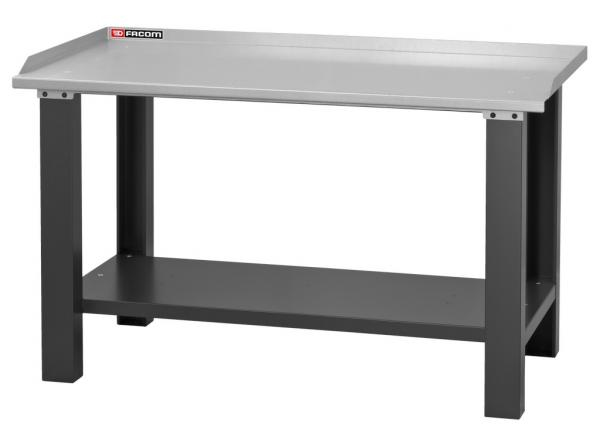
Industrial Maintenance Workbenches
Industrial workbenches are designed for heavy-duty applications wherein they are expected to withstand harsh conditions and continuous use. These types of workbenches are engineered to resist impact from machinery and equipment without bending or collapsing. Industrial workbenches are rated to be capable of holding high load requirements. A great example of maintenance workbench, equipped with a 2 meter wide galvanized steel worktop, is Facom’s WB.2000GSA workbench. This welded and bolted heavy duty metallic construction has a static load resistance of 700 kg and it can be enriched by adding some drawers to it. A great example of a workbench with drawers is the USAG U05160020, equipped with a 40 mm thick wooden worktop and 6 drawers in which you can store all your work equipment. Another model worth to be considered is the Facom JLS2-2MS7DSCL heavy duty workbench, provided with 7 drawers, as well as a worktop covered with a stainless-steel coating. Professionals can benefit from a complete visibility and access to the tools thanks to the vertical hook panels. Take a look at the USAG 516 SPC2 workbench too: it is characterized by a galvanized steel top with 37 mm sides, plus drawers on telescopic ball bearing slides that can be completely opened. Each drawer can store 3 modules and features high-resistant handles in ABS
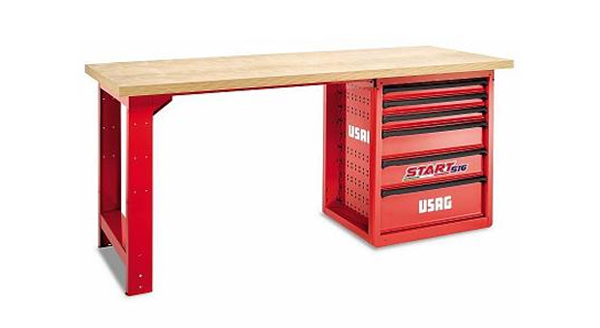
Portable Workbenches
Another really common type of workbench, practical for workers that need to move their equipment constantly, is represented by portable workbenches. Such models are typically used for lighter applications requiring easy movement of a workstation. These benches are designed to be conveniently inserted into workstations that do not require a permanent work surface.
Portable workbenches are typically constructed with caster wheels and folding legs. One of the most popular products is the Stahlwille 96/3 rolling workbench. It features a retractable tool panel, together with 5 steel drawers mounted on ball bearings, provided with slotted liners for dividing the drawers. This unit is also equipped with an aluminium handle for a facilitated transport. Moreover, the worktop of this Stahlwille workbench is made of 50 mm thick, water- and warp-resistant, glued multilayer beech wood with a transparent varnish finish.
Another example of rolling workbench, available in the Mister Worker™ catalog, is the Hazet 179NW-8/244 model, featuring 8 flat drawers, as well as a 244-piece tool assortment in Safety-Insert-System soft foam padding. This product is also equipped with 2 swivel wheels with double stop function: the fixed wheel prevents unintentional rolling of the trolley, while the fixed swivel bearing stops the wheels from turning on sloping surfaces. Furthermore, the protective ring blocks the access of dirt and threads and elastic tyres guarantee a fluid movement.
Also folding workbenches are to be considered as a part of these types of workbenches. An example is the Stanley Fatmax Folding Workbench FMST1-75672: its peculiarity is represented by an intelligent leg opening / closing system that enables you to position the table quickly and allows for increased storage capacity. If you purchase this model, you can benefit from a large work surface, plus a practical handle for opening and hanging tools. This Stanley Fatmax Workbench is quick and easy to open and close and, once closed, it does not take too much space.
Metalworking Workbenches, Woodworking Workbenches and many other
As we have already explained before, there are different types of workbenches that adapt perfectly to specific applications. Among the most commonly used workbenches there are surely metalworking and woodworking workbenches: the main features that they should have are simplicity, durability, and repairability.
Metalworking workbenches are designed for heavy duty applications and usually they have a really high load resistance. Therefore, they are very sturdy, strong, durable, and stable. These types of workbench, for example, in fabrication shops relating to shaping metal by welding, light castings, and grinding. Many metalworking benches are integrated with vises and clamps for holding metalwork parts.
Woodworking workbenches are used as workstations for shaping and building wood projects. They come in many size ranges, where larger benches are for complicated projects involving more significant components (e.g., building staircases, assembling framing, and planing surfaces)
Furthermore, there are specific workbenches for electronics and for cleanrooms. In the first case, the workstation is used to carry out operations of repairing electronic components and equipment; that is why they must have power sources integrated with them. These types of workbenches are specifically grounded with ESD because of electronic equipment sensitivity.
On the other hand, cleanroom workbenches are specially designed to meet the high standards of cleanrooms. If you’re looking for a workbench for this specific scope, you should pay attention to the fact that all surfaces should be made from non-porous materials such as steel, aluminium, or plastic. It is fundamental that the worktop is resistant to harsh chemicals, petroleum products, rust, and solvents.
Discover our wide assortment of workbenches online on misterworker.com and buy the one that suits you best.
Related products
Maintenance workbench -…
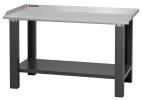
Maintenance workbench -…
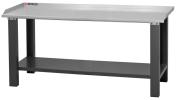
START WORKBENCH WITH WOODEN…
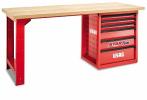
WB 620 Mobile workbench
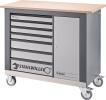
FATMAX® EXPRESS -tm-…

Mobile work bench 8 drawers…

Mobile workbench 5 drawers

Heavy-duty workbench 2182…
